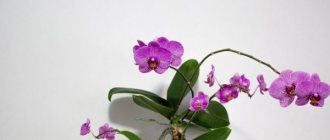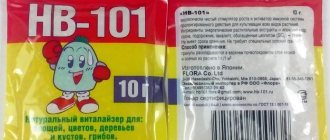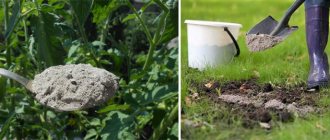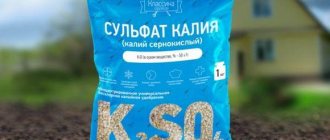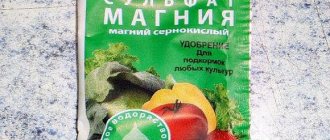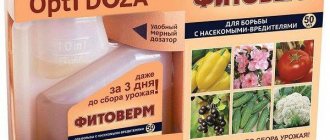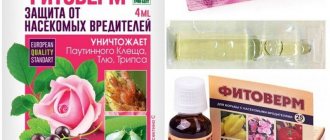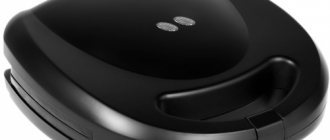Category: Popular brands Reading time: 8 min · Views: 8,915
Preparations that stimulate plant growth began to be used by gardeners not so long ago. Gardeners who actively use growth stimulants note that after treatment, plants become more resistant to infections, grow better and begin to bear fruit earlier than untreated crops. A prominent representative of a growth stimulator is the drug “Bud”.
Composition of the drug Buton
Before using Bud to stimulate the growth of flowers and vegetables, you need to study its composition and instructions for use.
We’ll get acquainted with the instructions later, but now let’s try to figure out the unclear names of the substances that make up the drug. The active ingredient is sodium salt of gibberellic acids. For growth and development, each plant cell requires, in addition to the nutrients and water that they extract from the environment (soil, air), various chemicals. Scientists have discovered more than 100 gibberellic acids in plants, which are natural growth hormones, and have learned to produce them artificially (synthetic substances). Gibberellic acids stimulate the germination of even old seeds, increase yield, and shorten the period of fruit ripening.
Humates. Natural, natural components obtained from plant residues, peat extracts, manure, silt. Potassium humate, which is part of the Bud, is a whole complex of natural microelements, vitamins, mono and polysaccharides and other useful substances.
Read reviews about the drug narcissus for plants, as well as a detailed description of it.
Microelements. For plants to grow and develop, a small amount of microelements is enough. Fertile, well-fertilized soils independently compensate for their deficiency.
- If a plant lacks boron, it is susceptible to diseases, the ovary falls off, and the roots and apical buds gradually die off.
- Copper increases resistance to fungal and viral diseases and reduces environmental impact.
- Manganese takes part in cell photosynthesis, increases the yield and quality of fruits.
Details
Composition of Agricola fertilizer and instructions for use for plants
Main advantages
- Helps increase yield;
- With the help of organic substances, plant growth is stimulated;
- Reduces the formation of barren flowers, increases the number of ovaries;
- Increases the germination of seeds of vegetable, cereal, tuber, and ornamental plants;
- Increases resistance to drought, frost, and lack of sunlight;
- Strengthens resistance to transplants into open ground, viruses and fungal diseases;
- Reduces ripening time by 5-10 days.
The composition of the drug "Bud" includes active and auxiliary substances such as:
- Gibberellic acids (GA3)
- Humates
- Micro and macroelements
- Polysaccharides.
Gibberellic acids are natural growth hormones. With their help, plant growth and seed germination are regulated.
Today, more than a hundred different types of acids are known and scientists have learned to synthesize them artificially.
One plant can contain several types of different acids. For example, rice contains 14 types of acid, and corn 12.
The main direction in the use of gibberellic acid is seed treatment in order to increase germination.
It is also used to treat old seeds. Experiments have proven that after using “Bud”, old seeds germinate.
Seeds treated with the product begin to grow quickly. To avoid tilting of the plant, it is necessary to add more soil under the bush and hill it up.
Humates are a large group of preparations that are made from salts of humic, easily soluble acids.
On a note!
Humates are natural substances produced from manure, peat extract, and sludge residues.
Ballast and non-ballast fertilizers are obtained from these substances.
- Ballastless - contain many active substances and are growth stimulants.
- Ballast - are fertilizers.
The composition of the “Bud” product contains: potassium and sodium humate.
They have a beneficial effect on the physical properties of the soil, its structure and characteristics.
The use of "Bud" in gardening further reduces the cost of using nitrogen fertilizers by up to 50%.
Microelements – well-fertilized soils nourish plants with essential macro and microelements.
- Cell photosynthesis requires manganese. Thanks to it, the quality and quantity of fruits increases.
- To strengthen the root system, buds and ovaries, boron is needed. It helps the plant accumulate sugar, for example in potatoes, berries, and root vegetables.
- The presence of copper increases immunity and resistance to various diseases.
Purpose of the drug "Bud"
The instructions for use of the “Bud” product contain recommendations for use on all parts of plants.
There are also recommendations for use for indoor plants. The components contained improve soil performance.
This type of fertilizing can be used both for spraying and for watering at the root.
Spraying is carried out with a solution twice weaker so as not to damage the leaves.
Composition and instructions for use
Bona forte: concentrated liquid fertilizer and food for orchids.
The main active ingredient is sodium salts of gibberellic acids (20 g/kg), the drug is enriched with humates and microelements.
To prepare a working solution, dissolve the drug in a small volume of water (from the tap) and stir it thoroughly. Then bring the product to normal according to the instructions below and stir again. Plants should only be sprayed with a freshly prepared solution, and the leaves should be well wetted (if we are talking about foliar feeding). The active components will begin to work from the moment of application, the time of the protective effect from using the drug is 1-3 months.
Application of the drug for potatoes. To increase the yield, resistance to frost, and diseases of this vegetable crop, you need to treat the potato tubers with a solution based on Bud. To prepare the solution, dilute 15 g of the product in 10 liters of water, the solution consumption is liter per 100 kg. Then, during the budding period, the solution is prepared in the same way, the plants are irrigated (approximate consumption - 4 liters per 100 sq.m.).
Application of the drug for eggplants. Prepare the product and use it in the same way as it was done for spraying potatoes. The procedure will help increase the yield of eggplants and increase their resistance to various diseases.
Application of the preparation for cabbage. White cabbage must be processed to increase the amount of ascorbic acid in it and reduce the presence of nitrates. 10 g of the product is diluted in 10 liters of water, the cabbage is irrigated after the first leaf appears, then when there are 6-8 leaves, then during the period of setting heads. Preparation and consumption are similar to those described above for potatoes and eggplants.
Growth Promoter Benefits
Regarding the benefits of using the product, it is worth noting the following factors:
- increasing the percentage of crop germination, survival rate of seedlings and seedlings;
- increase in yield indicators (by 20–35%);
- increasing drought and frost resistance;
- strengthening resistance to pathogens of fungal, bacterial and viral infections;
- reduction in fruit ripening time;
- improving the commercial and taste characteristics of the crop;
- increasing the percentage of vitamins and minerals in fruits.
Increasing the percentage of crop germination is one of the advantages of “Bud”
Precautionary measures
- Use the drug only for treating plants.
- While working, use personal protective equipment (mask, goggles, gloves).
- Prepare the solution immediately before use.
- Dispose of unused solution.
- After work, wash your hands, glasses, gloves with detergent.
- Store all tools used for work out of the reach of animals and children.
Fertilizer double superphosphate instructions for use in the garden, composition, application rates
When processing, use personal protective equipment.
First aid for poisoning
[adsp-pro-5]
If poisoning occurs:
- The solution got into the mouth and stomach. It is necessary to do a gastric lavage and drink activated charcoal.
- The solution got into my eyes. Rinse with plenty of running water.
- The solution entered the lungs. If you are hypersensitive to the components, an allergic reaction may occur. Stop work and move to a safe place. Take off your clothes; there may be solution on them, this will make the situation worse.
Attention! Any poisoning is dangerous to your health, be sure to visit a doctor.
Instructions for use
Mullein as a fertilizer: composition, benefits, methods of preparation and use
Any drug, including Bud, should be used strictly according to the instructions. Only then will he be able to bring maximum benefit and benefit. It is sold in the form of a soluble powder, packaged in 2 gram bags. The drug is easy to dilute in water, as it has no sediment. Based on the instructions, you need to take 2 or 1 grams of product per liter of water. Everything will depend on whether you need a one percent or two percent solution.
For example, to treat fruit trees you need a two percent solution of the drug. For a young tree, one liter of solution is enough, and for an older tree, three liters of solution must be used. Trees should be sprayed twice: first during the flowering period, then when the ovaries appear.
For berry bushes, it is enough to prepare a one percent solution, and they should be treated only once - during the flowering period. For indoor and garden flowers, according to the instructions, a one percent solution of the drug is also used. Indoor flowers can be treated during the period of bud formation, if the flower was recently planted, as well as weakened and poorly growing flowers.
Effective acceleration of ripening: Tomato bud. Instructions for use of the drug
Stable fruiting, an abundance of ovaries that are resistant in any weather are the dream of gardeners. For this purpose, fruit formation stimulants are used. A proven remedy is Bud, which improves survival rate and increases stress resistance. When properly processed, it preserves and doubles yields.
Compound
For all gardeners, the pressing question is what to feed tomatoes during budding and flowering so that productivity is maximized.
Fertilizer Bud for tomatoes is an effective product from the group of natural activators.
What's in it:
- Sodium salt of gibberellic acids. Obtained artificially. It is a valuable growth factor. Accelerates ripening, increases yield levels. Activates rapid germination, increases the percentage of germination even of seeds older than 4-5 years.
- Humates. Synthesized from organic waste extracts. The raw materials are manure, litter, humus, compost, silt and peat. They contain simple and complex saccharides, many chemical elements, and a rich composition of vitamins.
- A set of microelements. Boron to improve tying. Stimulation of root and bud growth. Copper to strengthen immunity against tomato pathogens. Manganese is necessary for metabolic processes and photosynthesis. With its presence, product and taste criteria are improved.
Purpose of the stimulant
The product Bud for tomatoes stimulates the most important processes:
- fruit setting and filling;
- growth and expansion.
And also among the worthy effects that the drug causes:
- increases productivity;
- improves resistance to pathogens;
- enhances cold resistance;
- increases heat tolerance.
Methods of application
The drug is used in several variants. Most often spraying is carried out. Irrigation is used several times during the cultivation period:
- At the seedling stage, 2 times in 10 days and 10 days after picking.
- During the period of intense growing season to increase green mass.
- At the very beginning of flowering.
- At the setting stage to form more fruits in the clusters. At this moment there should be 3 first clusters on the bushes.
The drug is a powerful stimulant for seeds. By soaking them before planting, you can significantly increase germination and germination.
Instructions for use
Why do tomato buds fall off even though flowering is in full swing?
- micronutrient deficiency;
- weak ovary due to lack of gibberellin acids;
- diseases and pests, weakened immunity.
How to feed tomatoes during budding? In the arsenal of experienced farmers there is always an effective remedy, one of the best is the Tomato Bud. Sold in sachets of 2 g. Prepared in a dilution of 1% or 2%.
How to dilute Bud 2 grams for tomatoes according to the instructions for use:
- Take 1 liter of settled water at room temperature.
- Dilute 2 g of the product from the sachet in a small amount of heated water.
- Mix thoroughly.
Spraying rules:
- for the first irrigation use 1% preparation;
- second and third 2% solution;
- adult tomato bushes are treated only 3 times.
In order to consistently obtain large yields in protected conditions, tomatoes are treated with Bud in a greenhouse. Product consumption is 1 -1.5 liters per 10-15 m2.
For the ovary use:
- In a 1% dilution, 1 g of stimulant is dissolved in 1 liter of liquid;
- In the form of a 2% solution, 2 g of the drug is added to 1 liter of water.
How to dilute the preparation bud for tomatoes correctly:
- Dry powder is poured into a small amount of warm liquid.
- Dissolve until the sediment completely disappears.
- Bring to the desired volume by adding liquid.
Stimulant dilution
The procedure is performed according to certain rules:
- use specially designated containers for processing tomatoes;
- the powder is poured into water heated to 25 degrees, and not vice versa;
- To obtain a volume of 1 liter, add water.
Precautionary measures
The drug is included in the group of hazard class 3 drugs. What are the characteristics of the drug:
- does not disturb the soil structure;
- does not harm insects and microorganisms;
- does not poison pets.
Comply with the protection rules:
- use the solution exclusively for plants;
- work in a mask, gloves, glasses;
- always prepare a fresh solution;
- the remains are disposed of;
- wash instruments.
Storage conditions
The optimal temperature is not higher than + 30 degrees and not lower than 27-30 degrees. The drug is hidden from children and animals. Make sure the bags are sealed.
In order for tomatoes to delight with early fruits and an abundance of harvests, agricultural experts recommend Bud. The drug stimulates the appearance of multiple ovaries, strong and not falling off. Fruit delivery may occur 7-10 days ahead of schedule.
Storage
The drug belongs to hazard class III. It is non-toxic, does not cause poisoning of insects and animals, and does not destroy the soil structure. Shelf life: 2 years.
It is recommended to store in a dry place at temperatures up to + 30 degrees. Does not lose its properties when dropped to – 30 degrees. After the expiration date, the drug must be disposed of. Make sure that the packaging is not damaged and keep it away from children and animals.
Watch the video material about the growth stimulator Bud.
Regulations for the use of fertilizing for different types of crops
| cultivated plant | Effect of fertilizer Bud | Dilution rate | Working substance consumption | Features of using fertilizing |
| Tomatoes, cucumbers | Helps preserve ovaries under unfavorable conditions and increase yield | 1 g per 1 liter of water | 1 liter of solution per 20 sq.m. | Fertilizing is carried out during the budding phase, at the very beginning of flowering, as well as after the appearance of 1,2,3 brushes or during mass flowering |
| Helps in good head formation and increases ripening speed | 2 g per 1 liter of water | 1 liter of solution per 25 sq.m | During a mass shooting | |
| Legumes (peas, beans) | The process of fruit ripening accelerates, the protein content increases | 1-2 g per 1 liter of water | 1 liter of solution per 25 sq.m | Fertilizing is carried out during the budding and flowering phase of crops |
| Potato | Helps resist stress and illness; increases productivity, improves tuber quality | 15 g per 10 l of water (100 kg of tubers will require 1 l of solution) | 4 liters of solution per 100 sq.m. | Tubers are treated with the solution before planting |
| The amount of ascorbic acid increases, the nitrate content decreases | 10 g per 10 liters of water | 1 liter of solution per 25 sq.m | Irrigated after the appearance of the first leaf, then during the appearance of 6-8 leaves, then during the setting of heads of cabbage. | |
| Grapevine, strawberry | Stimulates the formation of berries and increases their size | 1-2 g per 1 liter of water | 1 liter of solution per 25 sq.m | |
| Stimulates the formation of fruits, promotes the preservation of ovaries during frosts, increases the speed of ripening | 1 g per 1 liter of water | 1 l - for young trees, 3 l - for old trees | From the beginning of the growing season, more precisely, from the pink bud phase. Feed up to 2 times a month |
Everyone who has ever tried to grow at least some kind of vegetable crop in their summer cottage has dreamed of a rich harvest. But not everyone managed to achieve the highest results during one summer season. And with such a remedy
, as Bud is a fruit formation stimulator, any desired results are quite possible. Thanks to this drug, the plants’ own strength is stimulated, the ecological purity of the fruit is improved, the ripening process is accelerated and the quality of flowers and fruits improves. Not only drought resistance but also frost resistance of the crop increases.
Multifunctional regulators
Today there are drugs on sale that not only regulate plant growth, but also have complex general strengthening properties. However, it is not always possible to accurately predict the response of plants to their use.
Zircon
In addition to root growth, this drug increases plant resistance to fungal diseases, prolongs the flowering period, increases productivity and helps to better tolerate unfavorable conditions (dry air, excess moisture, lack of lighting, high/low temperatures, etc.).
Mival, Mival-Agro, Energy-M
The preparations include silicon, which regulates respiration and accelerates the growth and development of plants. They are used to treat potato tubers; they are used to spray tomatoes, peppers and eggplants during the budding phase. This speeds up the ripening of fruits and increases the yield.
Furolan
This drug, created on the basis of biologically active substances of sunflower, increases the lignin content in plant tissues and increases their resistance to disease.
Ambiol
An immunomodulator, which is most often used for pre-soaking vegetable seeds. Ambiol solution increases the resistance of plants to frost, sudden changes in air temperature and lack of moisture, and also increases yield.
Krasnodar-1
This drug is used to accelerate the ripening of fruits and obtain an early harvest of tomatoes, peppers, eggplants, cucumbers and potatoes.
Amulet, Prorostok, El-1, Immunocytophyte
These regulators are based on arachidonic acid. Seeds, bulbs and tubers are soaked in their solutions, and the plants are also sprayed with them on the leaves. The drugs are used to increase plant resistance to diseases, accelerate the growth and development of green plants, and ripen fruits.
Carvitol
This drug contains acetylene alcohol, which has hormonal properties. It stimulates seed germination and plant development, increases productivity and improves the taste of fruits. Most often used for spraying tomatoes, peppers and eggplants.
Larixin
This immunomodulator is obtained from larch wood. Thanks to the active ingredient - dihydroquercetin, Larixin increases the immunity of plants and protects them from powdery mildew, septoria and root rot.
Krezacin
Biological product for stimulating seed germination, protecting plants from low and high temperatures, drought, lack of oxygen and vitamins. It is used for soaking seeds and spraying vegetable, fruit, flower and ornamental crops.
Albite
When released into the soil along with treated seeds, this drug promotes the proliferation of beneficial microorganisms and improves the absorption of nutrients by plants.
Narcissus
Thanks to the chitosan included in the composition (this substance is obtained from the shell of a crab), the drug activates the work of the root system and leaves, increases the resistance of plants to disease and stress.
Novosil, Biosil, Verva
These drugs contain triterpene acids. They are obtained from Siberian fir needles. The use of these regulators increases yield by 9-25%, accelerates fruit ripening, helps reduce storage losses, reduces the risk of developing fungal diseases, accelerates seed germination and increases their germination.
Use growth regulators strictly according to the instructions indicated on the package. Typically, the plant treatment procedure needs to be repeated several times. If you reduce this amount, the plant will begin to develop very quickly. Thus, the growth regulator will work as a stimulant.
Use growth regulators and stimulants correctly - and ornamental plants will delight you with lush and spectacular flowering, and garden crops will delight you with a rich harvest.
Instructions for use
Biogrowth stimulator "Bud" has several forms of release. There are drugs to increase fruiting activity, stimulate flowering and ovary formation in various garden crops, garden and indoor plants.
Table: consumption rates of fruit formation stimulant
Fruit formation stimulator
The most popular form of biological drug is considered to be “Bud. Fruit formation stimulator." The product is used for treating seeds and spraying various vegetable, fruit and flowering crops.
The contents of the package are dissolved in warm water. The dosage of the finished solution and the degree of its concentration may differ significantly:
- Apple tree - 2 liters of water and 2 g of product. To spray an adult tree you will need 2.5-3 liters of the prepared solution, a young tree - 1 liter.
- Apricot, cherry, currant bush - 2 liters of water and 2 g of powder. Each plant (young or “old”) requires 1-1.5 liters of ready-made stimulant.
- Grapes, strawberries - 100 liters of water and 2-4 g of the drug. To treat 100 m² of vineyard or strawberry planting, use 4 liters of liquid.
- Onion - 2 liters of water and 4 g of activator. This amount of solution is enough to spray 50 m² of garden. The procedure is carried out during the period when the bow is throwing arrows.
- Cabbage - 2 liters of water and 2-3 g of product. Treatment is carried out at the flowering stage and during the formation of 6, 7 and 8 cabbage leaves. For 50 m² of beds you will need about 2 liters of diluted concentrate.
- Potatoes - 2 liters of water and 2-4 g of stimulant. To treat 100 kg of planting tubers, you need to prepare 1 liter of solution. To spray the beds during flowering (100 m²), you will need at least 4 liters of liquid stimulating fruit formation.
For cucumbers, zucchini and squash
Processing of squash, cucumbers and zucchini is carried out three times per season:
- after the formation of the first leaf plate;
- at the stage of inflorescence formation;
- at the initial stage of ovary formation.
For tomatoes, peppers, eggplants
The finished solution (2 liters of water and 2 g of product) is enough to treat 40 m² of garden or greenhouse. The first spraying of tomatoes, eggplants and peppers is carried out at the stage of bud formation, the subsequent ones - during the flowering period of the first, second and third clusters.
Failure to comply with the above deadlines is the reason for the lack of results from treatment with a fruit formation activator.
For garden and indoor flowers
For 2 liters of water, 2 g of concentrated powder is required. Treatment is carried out at the stages of flowering and budding, as well as when planting/transplanting flowers. In rare cases, it can be replaced with the drug "Uniflor Bud".
Indoor care
Regular moistening and fertilizing of the soil is how you basically care for your precious orchid at home.
Watering
Ludisia prefers to grow in moist soil, without experiencing severe drying out of the substrate. If drying is allowed, then only the top layer of soil on the eve of the next watering.
As with all orchids, watering is preferable for ludisia by immersing the pot in water. The flowerpot is placed in a basin with warm water to the middle of its height for 30 minutes.
At this time, moisture has time to penetrate to the roots, and before installing the flower in its place, the excess liquid is allowed to drain well. If such watering is not possible, you can moisten the soil in the usual way from above.
It is important that drops do not fall into the base of the leaf rosettes or onto the shoots themselves. The frequency of watering depends on the air temperature and is especially frequent in the summer.
During the cold period, the soil is moistened the next day after its top layer dries
The frequency of watering depends on the air temperature and is especially frequent in the summer. During the cold period, the soil is moistened the next day after its top layer dries.
For irrigation, only soft water is used - boiled or collected during rain (snow). Its temperature should be slightly above room temperature.
It is useful to spray the leaves several times a week, which will increase air humidity and remove accumulated dust. You just need to use a fine spray bottle and keep it half a meter from the plant.
Fertilizer
Universal fertilizers or formulations for other plants are not suitable for ludisia. The ratio of organic and mineral substances necessary for it is contained in fertilizers for orchids.
The fertilizer is diluted in a dosage slightly less than indicated on the package and applied after the next watering.
Important! Do not water dry soil with fertilizer, since the concentrated chemical composition will be actively absorbed by the plant and burn the roots and leaves.
The frequency of fertilizing varies depending on the time of year. In spring and summer, at the peak of growth, it is recommended to water the flower with fertilizer every 3 weeks. In winter, it is enough to feed the precious orchid once every 1.5 months.
Flower growers note better plant growth with fractional and frequent application of fertilizer. For example, in the summer the entire dose is divided into 3 parts and fed in a small portion every week.
This reduces the risk of chemical burns, nutrients are better absorbed, and more lush growth and flowering are observed.
Bloom
Orchids bloom during the cool period in late autumn or early winter. The top of each shoot is decorated with a long peduncle with small buds. At this time, it is better to keep the flower at a temperature no higher than 18 ° C, which will extend the flowering period to a month.
After the buds dry out, the peduncle is cut off, which stimulates branching of the shoot and the formation of new branches in the following spring.
Rest period
The precious orchid does not have a pronounced rest period. On the contrary, it has the most active flowering period in winter.
In order for the plant to have time to regain its strength after the fall of color and actively grow in the future, it is forced to rest. To do this you need:
- cut off all flower stalks;
- leave the pot cool (up to 18 ° C);
- stop feeding;
- reduce watering and leave the top layer of soil dry for 1 day.
Ludisia can safely remain in this mode until spring, when it needs to be returned to its usual conditions.
Indications for use
Indications for use of Motherwort tincture include:
- arterial hypertension in the initial stage;
- neurotic and asthenoneurotic painful conditions occurring with sleep disturbances;
- neurocirculatory dystonia;
- feeling of irritability;
- neurasthenia;
- manifestations of vegetative-vascular dystonia;
- tachycardia and increased excitability observed with hyperthyroidism;
- neuroses of cardiovascular origin;
- vegetative neuroses during premenopause, accompanied by cardialgia, tachycardia and elevated blood pressure;
- mild sleep disturbances;
- emotional excitement.
Reviews about the drug Buton
Natalya Ivanovna. I tried using Bud for hot pepper. It bloomed all the time, but the ovary fell off. The store offered Bud. We saw the result in two weeks: the ovaries are like the sea! Holds tightly and does not fall off.
Semyon. I read about Tomato Bud - the reviews are the best. I decided to try it and processed it three times as written in the instructions. The first tomatoes ripened a week earlier than usual. And what else I noticed was that they almost didn’t get sick.
Petrovich. I have been using the bud for growing cucumbers for a long time, now I decided to try it on potatoes. For testing, I soaked the bucket for 5 hours, and then immediately planted it in a separate area. My experimental one sprouted three days earlier and grew more amicably. The size was not very different, and in each hole there were 3-5 more pieces. Next year I'll process everything.
Price
The drug in a volume of 2 g costs about 20-25 rubles, in a volume of 10 g. – from 55 rub.
Each plant has its own norms of growth and development. They are due exclusively to the natural qualities of this representative of the flora. But not so long ago, so-called stimulants have become fashionable among gardeners, which accelerate growth, increase fruiting and allow you to get a much larger harvest. Let's find out if this is really true, taking as an example a drug such as the plant growth stimulator "Bud".
It contains sodium salts and the substance gibberyllic acid - a component of natural plant phytohormones responsible for flowering and fruiting of crops. Gibberellins help speed up flowering (for this the plant must be treated before budding), and then fruit formation (repeated treatment is necessary after the formation of ovaries).
Features of the use of the drug for different crops
As you know, “Bud” can be used for a wide variety of garden plants, a detailed list of which is given in the instructions for this growth stimulator. Let's consider this issue in more detail.
First you need to prepare a working solution for treating plants. To do this, take 10 liters of water and add 10 g of the drug (for currants, white cabbage, cucumbers), 15 g (for tomatoes, potatoes, eggplants) or 20 g (for onions, legumes, and flower corms). The consumption of working fluid for processing different plants is also different: cabbage, tomatoes, eggplants, potatoes, daikon radish, strawberries, cucumbers, peas, beans and onions require a maximum watering of 4 liters of solution per 100 square meters. m of planting area. Fruit trees consume a little less - 2-3 liters will be enough for apple and cherry trees, and only 0.5 liters per bush for black currants.
Separately, you should specify the time when you need to use the “Bud”. As mentioned above, this drug is used twice if the goal is to stimulate both flowering and fruit formation. However, for each crop, treatment with a stimulant is carried out at a different period of development:
- tubers are processed before planting;
- tomatoes - in the phase of the beginning of flowering of the first three clusters;
- eggplants - during budding, and after - at the beginning of flowering;
- For three phases of processing are permissible - at the appearance of a real leaf, when 6-8 leaves are tied and at the beginning of the tying of the head of cabbage;
- cucumbers are also sprayed three times - when a real leaf appears, at the beginning of flowering and during the period when the plant blooms en masse;
- Strawberry growth is stimulated only once - in the flowering phase;
- Flower corms are soaked 5 hours before planting in the ground.
When working with "Bud", as with other growth stimulants, be sure to adhere to the method of use indicated on the package. Otherwise, instead of a good harvest, you risk getting the opposite effect - from an oversaturation of phytohormones, the ovary will fall off without ever turning into fruit.
Practice shows that growth stimulants are indeed effective. Firstly, “Bud” increases resistance to adverse environmental conditions, namely drought and frost. Secondly, the use of this drug makes it possible to reduce the number of barren flowers and, accordingly, increase the number of fruit ovaries. This increases yield by 30-40% depending on the type of crop. Thirdly, thanks to the gibberellins contained in the composition with the growth stimulator “Bud”, the survival rate of plants becomes better. Fourthly, the crop ripens faster by about a week, and in gardening this is a considerable period of time
And finally, fifthly, the stimulant has a beneficial effect on the nutritional value and taste characteristics of the fruit, which is also very important
General information
There are preparations for treating seeds, stimulating seedlings, improving fruit set, and for controlling pests.
The drug “Bud” is an activator of growth and fruit formation in plants.
In the article we will look in more detail at its composition, active ingredients and methods of use.
Description and composition
In 2001, the Russian company TECHNOEXPORT developed a natural stimulator for flowering and fruit formation, called “Bud”.
It contains a complex of optimal active ingredients that are absolutely safe.
A proven complex that has earned the trust of gardeners and gardeners.
At the exhibition “Russian Farmer”, the Russian Agro-Industrial Exhibition (VVC), and also as an innovative drug, it received a gold medal.
Instructions for use
First of all, choose the type of preparation: Bud for garden and indoor flowers or for fruit formation. For maximum results, you should study the instructions and choose the method of application. The fertilizer is in powder form and is diluted in water.
Standard packaging: 2 g per bag. This is enough to obtain a liter of working mixture. The manufacturer recommends breeding strictly according to the proposed scheme.
Dilution of the drug
If Buton's working solution is prepared correctly, no sediment will be observed. To make the drug useful and effective, we follow the rules:
- the container for dilution must be dry, special (only for Bud);
- Initially, fertilizers are diluted in a small amount of water until completely dissolved;
- add liquid to the required volume. Use warm water. Under no circumstances should it be cold. Because this causes stress for any plant.
For each type of plant, the working solution must be fresh. Separate formulas are used:
- For indoor flowers, make a 1% solution (add 1 g of Bud per 1 liter of water). Treatment is carried out at the budding stage. As for the flowering period, it is better not to carry out any manipulations. Possible damage to appearance. Provided that the flower has suffered an illness, is weak or is developing poorly for other reasons, experts recommend spraying at least 3 times, adhering to a time interval (a week).
- For garden flowers, a 2% spray solution is used. But it is better to soak at the seed stage. For soaking, the formula is: half a liter of water + 2 g of Bud. Leave for 12 hours. Dry and plant in the ground.
- Vegetables. During the growing season, tomatoes, eggplants, and cucumbers are processed. The solution is made at 1% for the first time, subsequent times a 2% Bud mixture is used. Typically it takes up to 1 liter of mixture per 10-20 square meters. m. For cabbage, the technique for breeding and using Bud is similar to tomatoes. But the first treatment is done after the first 5 leaves appear.
- Potato. Planting material is soaked in a solution: 3 liters of water + 5 g of bud. This displacement is enough for 150-200 kg of potatoes. After the flowers appear, spray using a 1% solution.
- Berry and fruit bushes (trees). If young trees are planted, then you can spray or soak the rhizomes. Adult bushes and trees are sprayed at the rate of: 1 l - young tree, 3 l - adult, shrubs - from 0.5 to 1.5 l per unit. The solution is made 2%.
